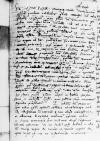List #449
Ioannes TRESLER do Ioannes DANTISCUSGdańsk (Danzig), [1534]-06-06
Regest polski:
Korzystając z dogodnego posłańca, Tresler przekazuje Dantyszkowi nowiny, zastrzega jednak, że nie jest przekonany co do ich wiarygodności.
Oto kupcy donoszą, że król Francji [Franciszek I] wyruszył na czele 50 000 wojska w kierunku Frankfurtu, wezwany tam przez pewnych książąt niemieckich, którzy kwestionują prawomocność wyboru Ferdynanda [Habsburga] na króla Rzymskiego; landgraf heski [Filip] i książę wirtemberski Ulrich w korespondencji z Ferdynandem podobno pomijają ten tytuł. Mówi się także, że landgraf z 20 000 swojego „zawziętego stronnictwa” (egenwilliga pars) postanowił zaatakować Księstwo Wirtemberskie. Wielu uważa, że działania te są rezultatem intryg króla francuskiego, ponieważ landgraf był ostatnio trzykrotnie we Francji, a jego żołnierze otrzymują żołd we francuskich koronach.
Lubeczanie, zebrawszy ochotników, zaatakowali Holsztyn i splądrowali kilka klasztorów i opactw. Ich śmiałym zamysłem jest uwolnienie króla Chrystierna [II] i wsparcie go w zdobyciu władzy w królestwach Danii i Szwecji, tak aby zemścił się za doznane tam przez nich krzywdy.
W Anglii również panuje wojna na lądzie i morzu. Wszystkie stany tego królestwa zostały zmuszone do nowego hołdu i przysięgi na wierność nie tylko królowi [Henrykowi VIII], lecz także potomstwu [które narodzi się] ze świeżo poślubionej przez niego małżonki [Jane Seymour].
Tresler pyta Dantyszka o nowiny z dworu cesarskiego na temat inwazji tureckiej na Peloponez i Węgry, oraz czy papież [Klemens VII] zamierza utrzymać pokój w Italii.
Na koniec prosi o przesłanie mu za pośrednictwem zaufanego posłańca dobrze opieczętowanych "ksiąg Elefantydy", aby mógł przeprowadzić ich porównanie z posiadanymi przez siebie ilustracjami (cum mea pictura). Deklaruje, że nie pragnie ich używać w praktyce, lecz jedynie studiować czysto teoretycznie.
| odebrano [1534]-06-09 Rękopiśmienne podstawy źródłowe:
| ||||
Tekst + aparat krytyczny + komentarz Zwykły tekst Tekst + komentarz Tekst + aparat krytyczny
Reverendissimo in Christo praesuli et domino, domino
Ventilantur nobiscum quidam rumores, quibus tametsi non adeo fidendum existimem, non potui tamen praetermittere, quin habito tam opportuno nuntio ea ad Reverendissimam Dominationem Vestram paucis perscriberem. Referunt (vel nugantur) mercatores
 BK, 230, p. 272 ab
BK, 230, p. 272 ab
Nec pacatiora ex
Si Reverendissima Dominatio Vestra quid habeat ex aula
Insuper rem mihi gratissimam fecerit Reverendissima Dominatio Vestra, si per commoditatem
cf. Mart. 12.43.3–5 Quales nec Didymi sciunt puellae, / Nec molles Elephantidos libelli, / Sunt illic Veneris novae figurae; Priapea 4 Obscenas rigido deo tabellas / dicans ex Elephantidos libellis / dat donum Lalage rogatque, temptes, / si pictas opus edat ad figuras.; Suet. Tib. 43.2.1-5 Cubicula plurifariam disposita tabellis ac sigillis lascivissimarum picturarum et figurarum adornavit librisque Elephantidis instruxit, ne cui in opera edenda exemplar impe[t]ratae schemae deesset. ⌊
Cui me iterum atque iterum commendo.
Dat(ae) or Dat(um)⌈Dat(ae)Dat(ae) or Dat(um)⌉
Reverendissimae Dominationis Vestrae deditissimus


